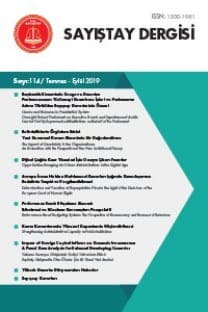SAYIŞTAYIN YARGI YETKİSİ, YARGISAL GÖREVİNİN NİTELİĞİ VE YARGI KOLLARI ARASINDAKİ YERİ
Zaman her şeyde olduğu gibi kurumlarda da değişikliğe sebep olur. Sayıştay da kurulduğu günden bugüne geçen 152 yıllık süre içerisinde değişime uğramıştır. Başlangıçta yüce mahkeme (Mahkeme-i Kübra) olarak kurulan Sayıştayın zaman içinde en çok tartışılan fonksiyonu yargı fonksiyonu olmuştur. Öyle ki yargı fonksiyonuna sahip olup olmadığı, 1961 Anayasası ile hukuk dünyamıza giren Anayasa Mahkemesi nezdinde sekiz kez tartışma konusu olmuştur. Sayıştayın yargı fonksiyonu üzerinde yaşanan bu tartışmayı Prof. Dr. Pertev BİLGEN "Sayıştayın Yargı Düzeni İçindeki Yeri (Bir savaş Hikayesi)" adlı makalesinde, "57 yıl süren savaşı canavarlar kazanmış ama ... 56 yıl, bu yazının yazıldığı tarih itibariyle 65 yıl önce kuyuya atılan taşı çıkarmaya çalışanlar başaramamış... Veya kırk akıllı çıkaramamış Canavarlar ise taş üstüne taş atmış ... kuyu taş dolmuş" şeklinde hicvederek yazmıştır. 152 yıllık bir kurumun hala fonksiyonlarının tartışma konusu olması üzülecek bir durumdur. Bu durum biraz Anayasalarımızdan kaynaklanmış ise; biraz da Prof. Dr. Pertev BİLGEN'in söz konusu makalesinde de belirttiği üzere Sayıştay ile Danıştay arasında yaşanan yetki savaşından kaynaklanmıştır.Sayıştayın yargı yetkisi üzerinde yaşanan bu tartışmalar nedeniyle yargı kolları arasındaki yeri, yargılama faaliyetinin konusu ve niteliği ile yargılama usulü üzerinde yeterince durulmamıştır. Kanaatimizce Anayasa Mahkemesinin Sayıştayın yargı fonksiyonu ile ilgili son kararları karşısında artık Sayıştay yargısı, yargılama faaliyetinin konusu, kararlarının niteliği ve örgütlenmesi dikkate alınarak, ayrı bir yargı kolu olarak tanımlanmalı, kendine özgü bir usul kanunu çıkarılmalı ve bu yargı kolu ile diğer yargı kolları arasında çıkacak görev ve hüküm uyuşmazlıklarının çözümlenme biçimi açıklığa kavuşturulmalıdır
JUDICIAL POWER OF THE TURKISH COURT OF ACCOUNTS, THE PROPERTIES OF ITS JUDICATORY ROLE AND ITS PLACE AMONG THE BRANCHES OF THE JUDICIARY
Time causes changes in institutions as it does in everything else. The Turkish Court of Accounts (TCA) has also undergone many changes since its establishment in 152. However, one of its main properties has remained constant, yet debated. At its outset, TCA was set up as a Supreme Court. This capacity of the TCA, to act as a Supreme Court whose decisions cannot be appealed, has often been controversial. There’s an ongoing debate on whether TCA is a type of Supreme Court, or even a court in the strictest sense. The subject of whether the TCA has such a judicial function has been discussed at the Constitutional Court of the Republic of Turkey eight times since its creation with the 1961 Constitution. This discussion over the judicial powers of the TCA was addressed in a satirical article by Prof. Pertev Bilgen titled “The Place of the TCA in the Turkish Legislative System, a War Story”. He writes “Monsters won this war that lasted 57 years but...those who tried to take out the stones thrown in this well 65 years ago failed...nor it could be done by forty wise men...and Monsters kept on throwing stones one after another, and now the well is full of stones.”It is depressing that an institution with a history spanning 152 years still faces debates on its main functions. Although this ambiguity has resulted from our Constitution, it is partly due to the struggle of authority between the Turkish Court of Accounts and the Council of State as it is stated in the aforementioned article of Prof. Pertev Bilgen. For this reason, it is imperative that the powers and functions of the Institutions must be defined clearly and precisely in the Constitution so that there will be no room for such debates.Because of such discussions, TCA’s place among the branches of the judiciary, the subjects and properties of its judicial activities and its judicial procedures have not been deliberated sufficiently. In our opinion, especially in light of the recent decisions of the Constitutional Court on TCA’s judiciary function, it is high time to define the TCA as a separate branch of the judiciary, to adopt a procedure law unique to the TCA and to clarify the ways for the settlement of the disputes over the tasks and judgments among the branches of the judiciary in consideration of the judicial power of the TCA, the subject of its judicial activities, properties of its decisions as well as its organisational structure
___
- Anayasa Mahkemesinin 11.7.1991 tarihli ve 1991/21 Karar sayılı, 27.12.2012
- tarihli ve 2012/207 Karar sayılı, 28.02.2013 tarihli ve 2013/36 Karar sayılı ile 13.11.2014 tarih ve 2014/170 Karar sayılı kararları, http://www.anayasa.gov. tr/Kararlar/KararlarBilgiBankasi/ (Erişim Tarihi: 22.02.2015)
- BİLGE Necip, Medeni Yargılama Hukuku Dersleri, 1967 BİLGEN Pertev, Sayıştayın Yargı Düzeni İçindeki Yeri (Bir Savaş Hikayesi) İ.Ü. Siyasal Bilgiler Fakültesi Dergisi No: 7 (Nisan 1994)
- Danıştay 5’inci Dairesinin 31.01.2000 tarihli ve 1997/1377 E ve 2000/339 K sayılı kararı, http://emsal.danistay.uyap.gov.tr/VeriBankasiIstemciWeb/ GelismisDokumanAraServlet (Erişim Tarihi:22.02.2015)
- Diyarbakır 3’üncü Asliye Hukuk Mahkemesinin 14.06.2011 tarihli ve 2011/343 Esas ve 2011/677 Karar sayılı kararı GÖZLER Kemal, http://www.anayasa.gen.tr/yargiorgani.htm (Erişim Tarihi: 22.02.2015)
- GÖZÜBÜYÜK A. Şeref, İdari Yargı Ders Kitabı, 1970 Sayıştay 6’ncı Dairesinin 15.3.2007 tarih ve 75 sayılı ve 17.09.2012 tarih ve 1245
- sayılı İlamları ile 20.11.2013 tarih ve 1463 sayılı Ek İlamı ONAR Sadık Sami, İdare Hukukunun Umumi Prensipleri İ. Ü. H F. Y. , 1952
- Yargıtay Hukuk Genel Kurulunun 29.06.2011 tarihli ve 2011/4-206 Esas, 2011/461
- Karar sayılı kararı, http://emsal.yargitay.gov.tr/VeriBankasiIstemciWeb/ GelismisDokumanAraServlet (Erişim Tarihi: 22.02.2015)
- Yargıtay 13.Hukuk Dairesinin 21.02.2012 tarih ve 2012/3517 Karar sayılı kararı.
- ISSN: 1300-1981
- Yayın Aralığı: Yılda 4 Sayı
- Başlangıç: 1990
- Yayıncı: T.C. Sayıştay Başkanlığı
Sayıdaki Diğer Makaleler
SEÇİLMİŞ BAZI ÜLKELERDE MALİ KURAL UYGULAMALARININ DEĞERLENDİRİLMESİ
TÜRKİYE’DE DEVLET İÇ BORÇLARININ YÖNETİMİ: 2000 ÖNCESİ VE SONRASININ KARŞILAŞTIRILMASI
SAYIŞTAYIN YARGI YETKİSİ, YARGISAL GÖREVİNİN NİTELİĞİ VE YARGI KOLLARI ARASINDAKİ YERİ
SAYIŞTAY HESAP YARGISINDA İLLİYET BAĞI KAVRAMI
İŞYERİ MANEVİYATI VE ÖRGÜTSEL GÜVEN ARASINDAKİ İLİŞKİ ÜZERİNE BİR ARAŞTIRMA
